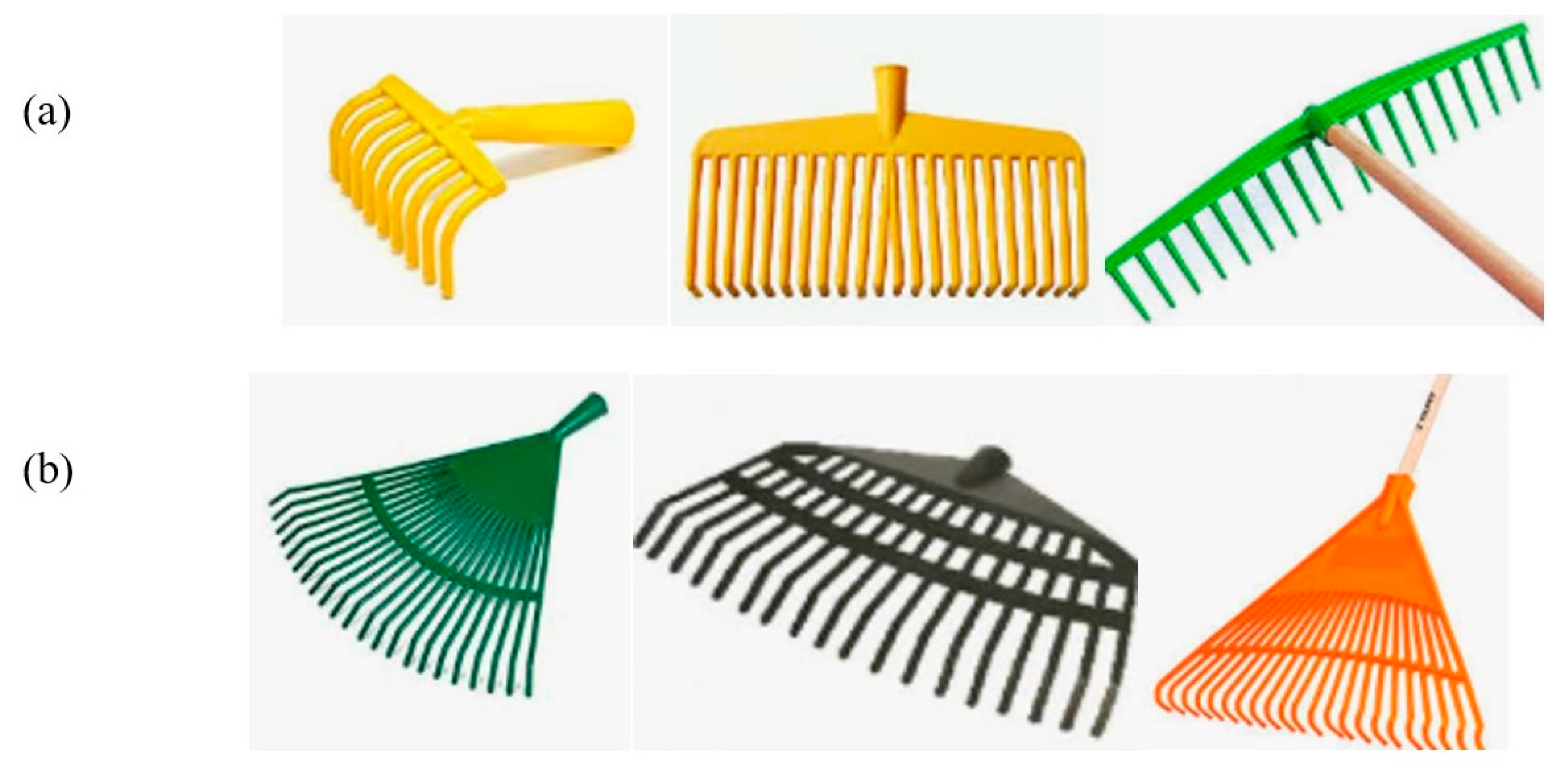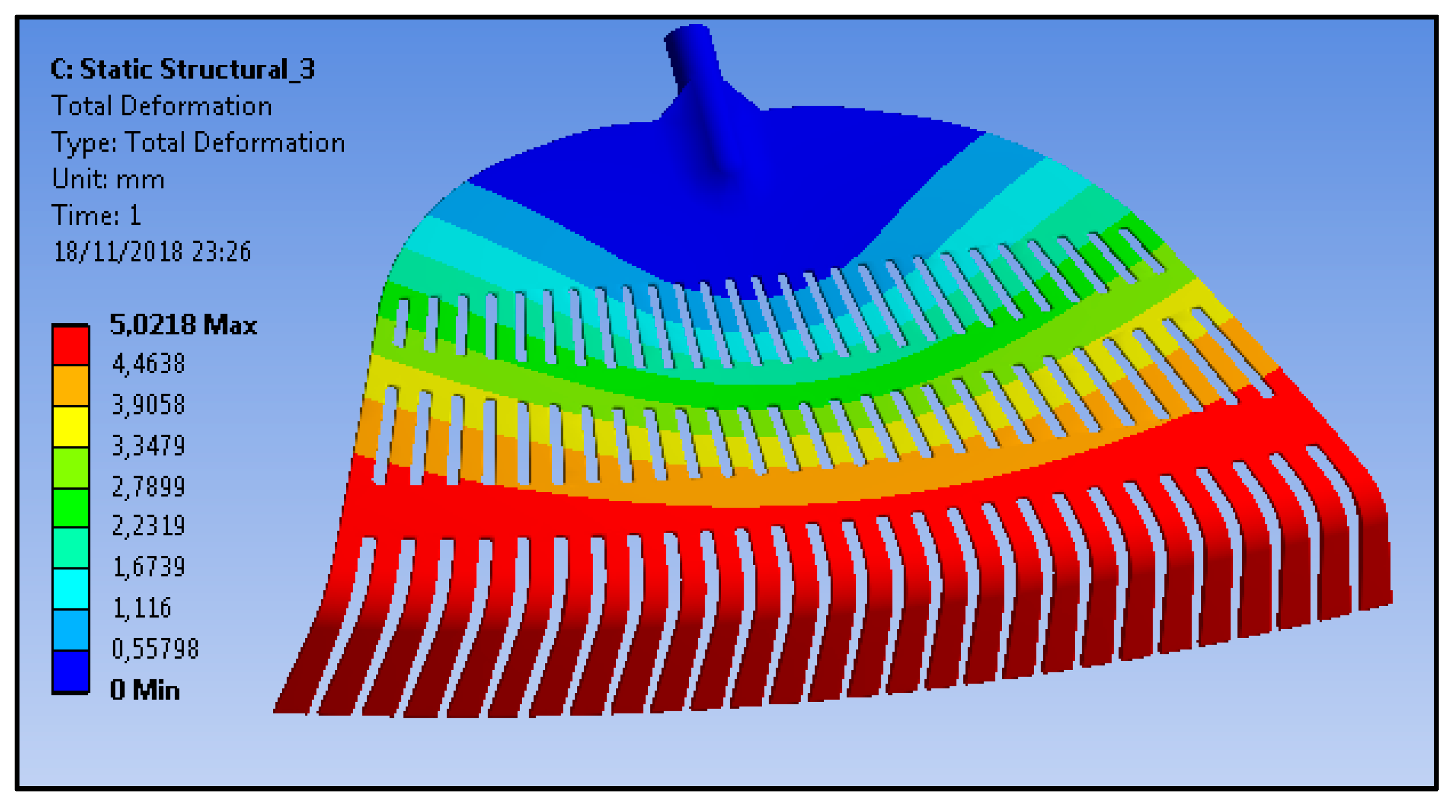To study the flow of tensions using the ANSYS software, neither the brand of the commercial product nor the hole in the handle were considered. These two “bodies”, so called by ANSYS, do not influence the tension level of the body, and thus their removal simplifies the study. Firstly, the behaviour of the tensions with the initial design values was observed, in order to obtain a first idea on how to improve the rake.
Figure 10 shows the nonstructured triangular mesh provided by this software by default. Using the “Refinement” command, it was possible to apply a condensation of triangles in the area where the handle is embedded with the body. Then, in a first static test, a “push” of the rake against the ground was simulated, applying an embedment in the interior of the handle and a displacement at the end of all the teeth, considering 5 mm in the horizontal direction backwards, and 0 mm in the vertical direction. The ambient temperature considered was 8 °C, as an illustrative average of the temperature at which the rake is used in the time of olive harvest. An average sweep duration of 0.4 s was considered.
Von Mises stress, deformation and factor of safety plots were obtained by conducting static structural analyses.
Figure 11 shows the factor of safety obtained in this first static test. It is the ratio of the yield to the maximum stress developed. The minimum factor of safety obtained was 1.6045 (≥1), which suggests that the hand-rake sweeper model is safe [
32,
33]. The results of this structural analysis indicate that the embedding area of the teeth had a lower factor of safety (1.60). Similarly, there was also a weak area in the adjacent area where the handle is coupled to the rake, showing even lower values of the minimum factor of safety, with this area being the one through which the tensions are transmitted to the body of the rake.
The result of the static test was 5.0197 mm of maximum deformation, which was concentrated in the final area of the teeth of the rake (
Figure 12). As is shown in
Figure 13, the areas with greater tension were located at the start of the final sections of the central teeth and the adjacent area where the handle is embedded in the main body of the rake, which needed to be strengthened by adding more material. The following values were obtained: 3.71 × 10
−7 MPa (minimum equivalent stress) and 155.81 MPa (maximum equivalent stress).
3.1. Design Optimisation
In a first attempt to improve and optimise the design, the aim was to reduce the volume of the product, thus minimising the tensions in the dangerous points. To this end, the following parameters were modified (
Table 4), located as they are in
Figure 14.
The distribution of tensions was determined again using the ANSYS software, obtaining lower von Mises tensions, from 155.81 MPa to 144.47 MPa, which is a 7.28% decrease (
Figure 15). This von Mises stress reduction are higher than the one achieved by Yang et al. [
34], which was 2.40%. Conversely, authors such as Ghosh et al. [
19] have succeeded in reducing the stress significantly by 27.22% in a guided robotic arm, after adding a support in the link which can cause failure. Yao et al. [
16], by modifying angular parameters, reached 36.4% von Mises stress reduction. Yu et al. [
35] achieved 31.89% von Mises stress reduction by reducing the weight of the structure. As is shown in Figure 18, the object was more relaxed regarding the distribution of tensions. Thus, after these results, it was observed that, in order to reduce the generated tensions, the upper ends of the body of the rake must be at 45°, as was previously indicated based on the strut-and-tie diagram.
However, the modification of such design parameters did not influence the deformation results of the test, obtaining a maximum total deformation of 5.0222 mm (
Figure 16). Next, to continue with the optimisation of the design, the width of the lower spikes was modified, which is a parameter related to the teeth (test 3). This parameter (W_Nerve_2) was increased from 27 to 40 mm to gather the tensions of the embedment of the teeth (
Table 5). That is, the start of the teeth was modified, changing from a plane to an arch. This modification was performed at the end of the optimisation. The other parameters were not modified since they were considered to be of little or no relevance in the optimisation.
Figure 17 shows that the maximum von Mises tensions increased to 212.15 MPa, which is a 46.84% increase from the value obtained in test 2 (144.47 MPa) and 36.16% with respect to the first test. Therefore, it is deduced that the increase in nerve width 2 was not relevant for the optimisation. However, the minimum von Mises tensions decreased 6.94% with respect to the improvement achieved in test 2. Similarly, Arcar et al. [
36], in one of their optimisation tests for an automobile torque arm, managed to maintain the maximum tension while decreasing the minimum tensions by 53.88%, although the optimal achievement in design optimisation is to decrease both the maximum and minimum tensions [
37,
38].
The total deformations did not show significant differences with respect to the values obtained with the first modification, after altering the following parameters: r 1 Handle, R L1-L2 and R L2-L3 (
Figure 18). Next, in test 4, the parameters related to the final section of the teeth were modified, i.e., the length (shortening) and radius (increase) of the teeth (
Table 6,
Figure 19).
In the third modification (test 4), the maximum tension decreased again, down to 144.87 MPa (
Figure 20), although that is still slightly higher than the result obtained in test 2. The maximum von Mises tensions decreased by 7.02% and the minimum tensions decreased by 74.64% with respect to the first test (initial level). However, in test 4, the obtained results are less promising than the ones obtained in test 2, in which the values of both tensions (maximum and minimum) were optimal.
Maximum tension values of 64 MPa were obtained in the teeth. Regarding the total deformations, it was in test 4 where tooth length was reduced and tooth radius was increased, obtaining the lowest maximum deformations, i.e., 5.0004 mm, which is 0.38% lower than the value obtained in the initial test, and 0.43% lower with respect to test 2 (
Figure 21).
Another improvement of the design of the rake, achieved in test 5, resulted from strengthening the lower embedment area of the handle where the tensions accumulate, designing it with excess thickness. Using ANSYS, a “Face Sizing” was applied to the strengthened area, in order to facilitate the capture of the points (
Figure 22).
In test 5, there were significant decreases in maximum von Mises tension (140.13 MPa), around 3.00% with respect to the value obtained in test 2, which makes it the optimal design. Moreover, there was a 47.58% decrease in the minimum tensions with respect to test 2 (
Figure 23). The tension accumulation areas that were strengthened showed lower tension values, between 62 and 77 MPa. By strengthening the lower embedment area of the handle, it was possible to reduce the maximum von Mises tension by 10.06% with respect to the initial test. However, regarding the values of total deformations obtained in test 5, where the lower embedment area of the handle was strengthened, there were no substantial improvements. The maximum deformation was reduced by 0.0206 mm with respect to test 2 (
Figure 24), and 0.0181 mm with respect to the initial situation. The total deformation decreased by 0.36% with respect to the initial test.





























